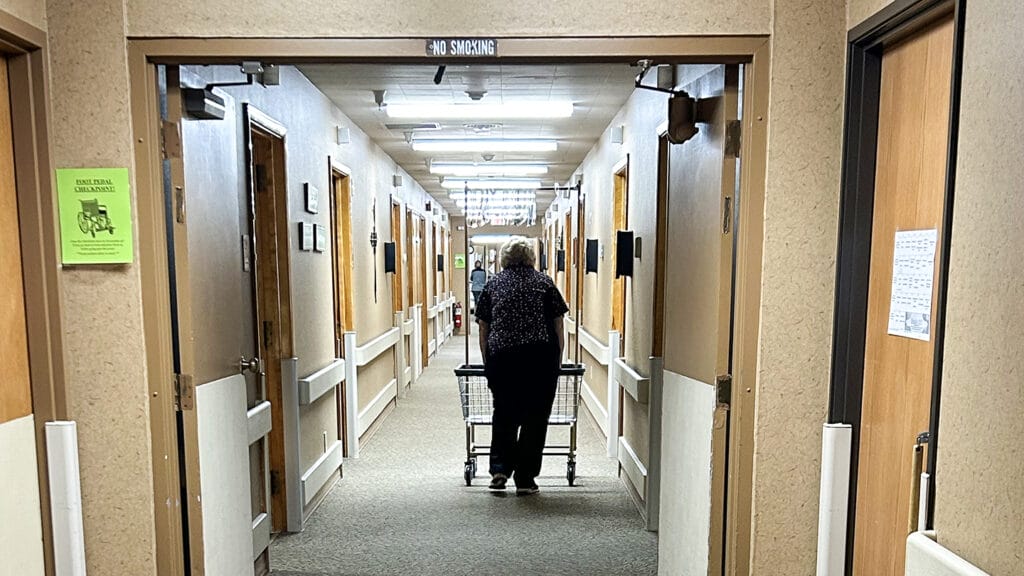News Items
Designing Inclusive Healthcare Spaces for Older Adults with Sensory Disabilities: Challenges and Solutions
Designing inclusive healthcare spaces for older adults with sensory disabilities presents challenges. Learn about ADA requirements and solutions in this post.
Designing inclusive and accessible healthcare spaces for older adults with sensory disabilities can present numerous challenges. While the Americans with Disabilities Act (ADA) serves as a baseline for accessibility design, it may not fully take into account the unique needs of older individuals. Understanding the specific ADA requirements for older adult spaces in each state is crucial. However, long-term care spaces should go beyond mere compliance with accessibility guidelines to truly enhance the quality of life for residents and provide support for staff. Designing with empathy for the senses becomes paramount, as issues like hearing loss, decreased touch sensitivity, vision impairments, changes in taste, and loss of smell need to be addressed. Incorporating design elements that promote relaxation, reduce distractions, improve lighting, offer menu options, and introduce pleasant smells can significantly enhance the well-being of older adults. Moreover, architects and planners can gain a deeper understanding of residents’ daily experiences and create functional living spaces through the use of virtual simulations and physical mock-ups.
Understanding ADA Requirements
Designing inclusive and accessible healthcare spaces for older adults with sensory disabilities can be challenging. The Americans with Disabilities Act (ADA) sets the standard for accessibility design, but it may not fully address the needs of older citizens. Each state has different guidelines regarding ADA compliance for older adult spaces, so it is important to understand the specific requirements in your area. Long-term care spaces must go beyond accessibility guidelines to enhance the quality of life for residents and provide support for staff.
Challenges in Designing for Older Adults with Sensory Disabilities
Designing with empathy for the senses is crucial when creating spaces for older adults with sensory disabilities. There are several challenges that need to be considered and addressed:
Hearing Loss
Hearing loss is a common sensory disability among older adults. To design for individuals with hearing loss, it is important to consider installing assistive listening devices such as hearing loops or captioning systems. These devices can help individuals better hear conversations, announcements, and other auditory information. Additionally, using visual alerts and signage can provide important information to those with hearing loss. Controlling background noise is also important to minimize distractions and improve communication.
Decreased Touch Sensitivity
Older adults may experience a decrease in touch sensitivity, which can affect their ability to navigate and interact with their environment. When designing for decreased touch sensitivity, it is important to choose contrasting colors and textures to make objects and surfaces easier to identify and differentiate. Providing handrails and grab bars in key areas such as hallways, bathrooms, and stairwells can also improve safety and mobility. Tactile flooring and braille signs can provide additional cues and information.
Vision Impairments
Vision impairments can range from mild to severe and can greatly impact how older adults navigate and interact with their surroundings. When designing for vision impairments, implementing bright and contrast colors can help individuals identify important features and navigate independently. Using large print and clear signage can also make information more accessible. Optimizing lighting and reducing glare can enhance visibility and reduce eye strain.
Changes in Taste
Older adults may experience changes in taste, which can affect their enjoyment of food and dining experiences. To design for changes in taste, it is important to offer a variety of menu options that cater to different preferences and dietary restrictions. Enhancing food presentation can also make meals more appealing and enticing. Using flavorful and textured foods can help stimulate the taste buds and enhance the overall dining experience.
Loss of Smell
Loss of smell, also known as anosmia, can impact the overall sensory experience for older adults. When designing for loss of smell, it is important to introduce pleasant smells in the environment to create a more enjoyable and stimulating atmosphere. Enhancing ambient odors can also contribute to a positive sensory experience. It is important to avoid harsh chemical odors, as they can be overwhelming and unpleasant.

This image is property of www.mcknights.com.
Design Elements to Enhance the Well-being of Older Adults
In addition to addressing specific sensory disabilities, there are design elements that can enhance the overall well-being of older adults:
Promoting Relaxation
Designing spaces that promote relaxation can help reduce stress and improve overall well-being. Incorporating comfortable seating areas, calming decor, and soothing colors can create a peaceful atmosphere. Providing access to outdoor spaces and natural elements, such as gardens or courtyards, can also contribute to relaxation.
Reducing Distractions
Reducing distractions in healthcare environments can help older adults focus and maintain their attention. Designing spaces with minimal visual and auditory clutter can create a more calming and peaceful environment. Using sound-absorbing materials, strategic placement of furniture, and thoughtful layout design can help reduce distracting noises and visual stimuli.
Improving Lighting
Good lighting is essential for older adults with sensory disabilities. Designing spaces with well-planned lighting can improve visibility and reduce eye strain. Using a combination of natural and artificial lighting sources can create a balanced and well-lit environment. It is important to consider lighting levels, color temperature, and glare reduction when designing for older adults.
Offering Menu Options
Providing a variety of menu options can cater to the diverse tastes and preferences of older adults. Designing dining spaces that are flexible and adaptable can accommodate different dietary needs and promote social interaction. Offering menu options that are easy to read and understand can help older adults make informed choices and enjoy their dining experience.
Introducing Pleasant Smells
Introducing pleasant smells can enhance the sensory experience for older adults. Aromatherapy and other scent-based design strategies can create a more enjoyable and stimulating atmosphere. For example, incorporating natural scents like lavender or citrus can promote relaxation, while incorporating aromas like freshly brewed coffee or baked goods can stimulate the appetite and create a welcoming ambiance.

This image is property of www.mcknights.com.
Beyond Accessibility Guidelines: Enhancing Quality of Life for Older Adults
While ADA guidelines and inclusive design principles are important, going beyond these standards can enhance the quality of life for older adults with sensory disabilities. Consider the following factors:
Creating Supportive Social Spaces
Designing spaces that encourage social interaction and connection can greatly enhance the well-being of older adults. Incorporating common areas, like lounges or community rooms, encourages residents to interact with one another and foster a sense of community. Providing comfortable seating arrangements and creating spaces for group activities or events can also promote social engagement.
Providing Personalized Care and Services
Offering personalized care and services can cater to the unique needs of each individual. Designing spaces that support activities of daily living, such as bathing, grooming, and medication management, can improve independence and autonomy. Providing access to healthcare services and support, such as physical therapy or counseling, can also enhance the well-being of residents.

This image is property of www.mcknights.com.
Conclusion
When designing healthcare spaces for older adults with sensory disabilities, it is crucial to prioritize inclusive design and understand ADA requirements. While ADA guidelines provide a foundation for accessibility, it is important to go beyond these standards to enhance the quality of life for residents. Designing with empathy for the senses and considering challenges such as hearing loss, decreased touch sensitivity, vision impairments, changes in taste, and loss of smell are essential. Incorporating design elements that promote relaxation, reduce distractions, improve lighting, offer menu options, and introduce pleasant smells can greatly contribute to the overall well-being of older adults. By creating supportive social spaces and providing personalized care and services, healthcare environments can truly enhance the lives of older adults with sensory disabilities.

This image is property of www.mcknights.com.
















